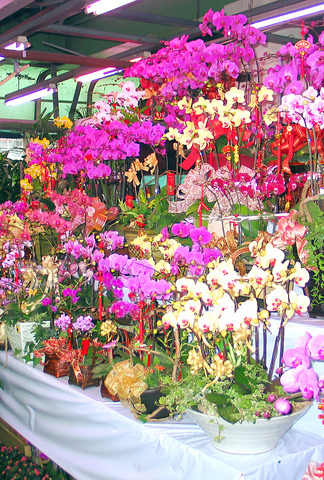Before sundown on Lunar New Year's Eve, you need to clean the house, settle outstanding debts, resolve any differences with family and friends and purchase the essential holiday flowers. The last project can be achieved at the flower markets under the Jianguo expressway, or in Neihu.
In preparation for the New Year celebrations, both markets flourish with an array of holiday plants, flowers and consumers.

PHOTO: DIANA FREUNDL, TAIPEI TIMES
On any regular weekend, Jianguo Flower Market (
While Jianguo is the more tourist-friendly market, Neihu boasts a larger size and se-
lection. Formerly part of the Bingjiang Street fruit and flower market, it relocated to the bigger venue in Neihu a few years ago. The market carries everything associated with plant life, from seedlings and gardening tools to gigantic potted plants. An early morning trip witnessed numerous florists stocking up on holiday flora to be sold at their own neighborhood vendors.
Most of the flowers sold at the market are grown in Taiwan, but there are a variety of imported plants and flowers. Orchids, kumquat trees, bamboo, water lilies and plum blossoms are the most in demand at this time of year, said Zhou Jing-ping (
"Any flowers or plants are suitable. People even buy daisies for their homes; but just don't give them [daisies] to someone, because they are associated with bereavement," he explained.
While each plant is associated with a particular meaning, fresh flowers and plants in general symbolize rebirth and growth, so they are an essential New Year's decoration.
Orchids or plum blossoms arranged with bamboo and pine stems are one of the most common combinations and symbolize perseverance, unity and longevity. Tangerines, oranges and kumquat trees are also popular for their representation of wealth and fortune.
In terms of pricing, the best deals are found in Neihu, where orchids sell for NT$200 per stem while more elaborate arrangements in decorative vases cost NT$2,500 on average . Kumquat trees range from NT$400 to NT$1,500 depending on size. Single flowers and bouquets sell for a fraction of what they cost at smaller markets. Twenty long-stemmed red roses, which cost NT$50 in the Neihu market, are sold for NT$200 or more by some flower vendors.
Filling a home with flowers may not bring wealth or career advancement, but without the roots there can be no fruit. And lucky is the home in which a plant blooms on New Year's Day: This foretells a year of prosperity.
To accommodate seasonal customers, the hours of operation at both markets have been extended until New Year's Eve. The Neihu Flower Market is located at 400, Rueiguang Rd, Neihu, (

This month the government ordered a one-year block of Xiaohongshu (小紅書) or Rednote, a Chinese social media platform with more than 3 million users in Taiwan. The government pointed to widespread fraud activity on the platform, along with cybersecurity failures. Officials said that they had reached out to the company and asked it to change. However, they received no response. The pro-China parties, the Chinese Nationalist Party (KMT) and Taiwan People’s Party (TPP), immediately swung into action, denouncing the ban as an attack on free speech. This “free speech” claim was then echoed by the People’s Republic of China (PRC),

Exceptions to the rule are sometimes revealing. For a brief few years, there was an emerging ideological split between the Democratic Progressive Party (DPP) and Chinese Nationalist Party (KMT) that appeared to be pushing the DPP in a direction that would be considered more liberal, and the KMT more conservative. In the previous column, “The KMT-DPP’s bureaucrat-led developmental state” (Dec. 11, page 12), we examined how Taiwan’s democratic system developed, and how both the two main parties largely accepted a similar consensus on how Taiwan should be run domestically and did not split along the left-right lines more familiar in

Specialty sandwiches loaded with the contents of an entire charcuterie board, overflowing with sauces, creams and all manner of creative add-ons, is perhaps one of the biggest global food trends of this year. From London to New York, lines form down the block for mortadella, burrata, pistachio and more stuffed between slices of fresh sourdough, rye or focaccia. To try the trend in Taipei, Munchies Mafia is for sure the spot — could this be the best sandwich in town? Carlos from Spain and Sergio from Mexico opened this spot just seven months ago. The two met working in the

Many people in Taiwan first learned about universal basic income (UBI) — the idea that the government should provide regular, no-strings-attached payments to each citizen — in 2019. While seeking the Democratic nomination for the 2020 US presidential election, Andrew Yang, a politician of Taiwanese descent, said that, if elected, he’d institute a UBI of US$1,000 per month to “get the economic boot off of people’s throats, allowing them to lift their heads up, breathe, and get excited for the future.” His campaign petered out, but the concept of UBI hasn’t gone away. Throughout the industrialized world, there are fears that